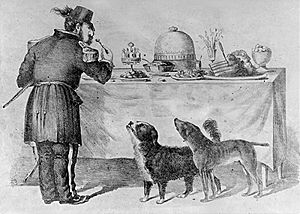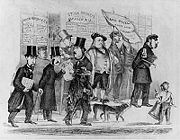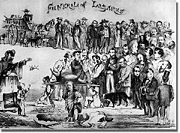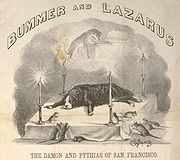
Bummer and Lazarus
Encyclopedia

California
California is a state located on the West Coast of the United States. It is by far the most populous U.S. state, and the third-largest by land area...
, USA, in the early 1860s. Recognized for their unique bond and their prodigious rat-killing ability, they became a fixture of city newspapers, were exempted from local ordinances and immortalized in cartoons.
Background
San Francisco, in common with other cities in the United StatesUnited States
The United States of America is a federal constitutional republic comprising fifty states and a federal district...
at the time, had a problem with free-ranging dogs. In Los Angeles
Los Ángeles
Los Ángeles is the capital of the province of Biobío, in the commune of the same name, in Region VIII , in the center-south of Chile. It is located between the Laja and Biobío rivers. The population is 123,445 inhabitants...
in the 1840s dogs outnumbered people nearly two to one, and while the situation in San Francisco had not reached this extreme, the large numbers of strays and feral dogs did cause problems. Dogs were regularly poisoned or trapped and killed. Nevertheless, if a dog turned out to be a good ratter or distinguished itself in some other way it was still possible for it to survive.
Meeting and career
Bummer was a black-and-white NewfoundlandNewfoundland (dog)
The Newfoundland is a breed of large dog. Newfoundlands can be black, brown, gray, or black and white. They were originally bred and used as a working dog for fishermen in the Dominion of Newfoundland, now part of Canada. They are known for their giant size, tremendous strength, calm dispositions,...
or Newfoundland cross
Dog hybrids and crossbreeds
A dog hybrid is a crossbreed of two or more different recognized breeds of dog.-Designer dogs:The Encyclopædia Britannica traces the term "designer dog" to the late 20th century, when breeders began to cross purebred poodles with other purebred breeds in order to obtain a dog with the poodles'...
who established himself outside the saloon
Bar (establishment)
A bar is a business establishment that serves alcoholic drinks — beer, wine, liquor, and cocktails — for consumption on the premises.Bars provide stools or chairs that are placed at tables or counters for their patrons. Some bars have entertainment on a stage, such as a live band, comedians, go-go...
of Frederick Martin in 1860 and quickly proved to be an exceptional rat-killer. His ratting talent spared him the fate of the former owner of the territory, Bruno, who had been poisoned with strychnine
Strychnine
Strychnine is a highly toxic , colorless crystalline alkaloid used as a pesticide, particularly for killing small vertebrates such as birds and rodents. Strychnine causes muscular convulsions and eventually death through asphyxia or sheer exhaustion...
shortly before Bummer's arrival. He scraped a living begging scraps from passers-by and the patrons of the saloon and other establishments along Montgomery Street.

Lazarus of Bethany
Lazarus of Bethany, also known as Saint Lazarus or Lazarus of the Four Days, is the subject of a prominent miracle attributed to Jesus in the Gospel of John, in which Jesus restores him to life four days after his death...
, and he proved to be an even more prodigious ratter than Bummer. As a team they turned out to be exceptional, once finishing off 85 rats in 20 minutes.
Their ratting talent and unique bond was seized upon by the city's press. Martin's saloon was a favorite haunt of newspapermen and journalists, so, with the dogs a fixture outside the bar, they never had to travel far for a story. The exploits of the dogs were recorded in detail in the Californian, Daily Alta California, Daily Morning Call and Daily Evening Bulletin, the editors vying with each other in their attempts to endow the pair's adventures with thrills and parallels to the human condition. Bummer was portrayed as the gentleman, down on his luck, yet still faithful and conscientious, while Lazarus, the mongrel, was cast in the role of the sly and self-serving fairweather friend. When Bummer was shot in the leg after only a couple of months, and Lazarus left him to run with another dog, it suited the press no end: Bummer was said to be feeling the sting of ingratitude at the desertion of the cur he had saved from death. Lazarus' return when Bummer recovered only added to the excitement.
The two dogs had the run of the streets, and when, on June 14, 1862, Lazarus was taken by a new dog catcher
Animal control officer
Historically, Dog whippers were charged with keeping dogs out of churches in 16th- to 19th- century Europe; they also sometimes filled a general animal-control role in villages, confining strays...
, a mob of angry citizens demanded his release, petitioning to have the pair declared city property so they could wander the streets unmolested. The city supervisors released Lazarus and declared he and Bummer were exempt from the city ordinance against strays. A week later the two were reported to have stopped a runaway horse. Despite their reputations, the two could be vicious: Bummer was a sheep killer and regularly fought other dogs in the street occasionally assisted by Lazarus (although normally Lazarus would restrict himself to barking encouragement). They also ransacked shops when they had entered unnoticed and been locked in by the owners.
Emperor Norton
The two dogs were sometimes seen in the company of the "Emperor of the United States", the eccentric Joshua A. Norton, and a popular legend made him their owner. However, no contemporary records make any mention of Norton being the owner and only one newspaper report made any connection between him and the dogs. The rumor may have arisen because the cartoonist Edward JumpEdward Jump
Edward Jump , was an artist and cartoonist of the 19th century, born in Paris, France. His early life is not well documented, but he emigrated to California in 1852, attracted to the United States by the California Gold Rush....
frequently featured the three together, most notably in The Three Bummers which showed Norton eating from a heavily laden buffet table while the dogs wait patiently for scraps. Norton was apparently outraged when he saw the picture displayed in a shop-front window: the imperial dignity was affronted by the depiction of His Majesty in the company of lowly dogs. Despite the apparent antipathy felt by Norton for the dogs, the close association was still being claimed in the 1950s:
Death of Lazarus

Fire apparatus
A fire apparatus, fire engine, fire truck, or fire appliance is a vehicle designed to assist in fighting fires by transporting firefighters to the scene and providing them with access to the fire, along with water or other equipment...
s, but contemporary accounts say he was poisoned by being given meat laced with "ratbane" after biting a boy. San Franciscans put up a $50 reward for the capture of the poisoner. A wit suggested that he be buried in a place of honor alongside other great men of the city. Jump produced a cartoon of his "Funeral" with Norton as the Pope performing the ceremony and Freddy Coombs
Frederick Coombs
Frederick Coombs was an eccentric who lived in San Francisco in the 19th century and believed himself to be George Washington. For a time he was as popular a figure as Joshua A. Norton, the "Emperor of the United States and Protector of Mexico", and his deeds were reported in the local newspapers...
, another San Francisco eccentric who claimed to be the reincarnation of George Washington
George Washington
George Washington was the dominant military and political leader of the new United States of America from 1775 to 1799. He led the American victory over Great Britain in the American Revolutionary War as commander-in-chief of the Continental Army from 1775 to 1783, and presided over the writing of...
, digging the grave. Notable San Franciscans formed the cortege and Bummer looked on mournfully. This may have led to the rumor that large numbers of San Franciscans turned out for Lazarus' funeral.
The dog was not buried though, but stuffed by a taxidermist and displayed behind the bar in Martin's saloon. (According to Dickson, Martin paid the taxidermist $50 to turn the dog over — even though its remains had already been claimed by the city council.) The Daily Evening Bulletin featured a long obituary entitled "Lament for Lazarus" in which they praised the virtues of both dogs and recounted their various adventures together.
Death of Bummer
Bummer continued alone, although Mark TwainMark Twain
Samuel Langhorne Clemens , better known by his pen name Mark Twain, was an American author and humorist...
reported a year later in the Daily Morning Call that he had taken a small black puppy under his wing. Nothing more was heard of the puppy and without his companion, Lazarus, Bummer was of less interest to the press. He died a lingering death in November 1865 after being kicked by a drunk, Henry Rippey. Bummer was still popular enough that, to avoid violence, the city immediately arrested Rippey, but he did not escape popular justice: on learning of his crime, his cellmate, David Popley, "popped him in the smeller".

Bummer was also mounted by the taxidermist and placed on display. In 1906, both specimens were donated to the Golden Gate Park
Golden Gate Park
Golden Gate Park, located in San Francisco, California, is a large urban park consisting of of public grounds. Configured as a rectangle, it is similar in shape but 20% larger than Central Park in New York, to which it is often compared. It is over three miles long east to west, and about half a...
museum (now the M. H. de Young Memorial Museum
M. H. de Young Memorial Museum
The M. H. de Young Memorial Museum, commonly called simply the de Young Museum, is a fine arts museum located in San Francisco's Golden Gate Park. It is named for early San Francisco newspaperman M. H...
) where they remained in storage until they were destroyed in 1910.
On 28 March 1992, a brass plaque commemorating the two dogs was placed at Transamerica Redwood Park, a small park adjacent to the base of the Transamerica Pyramid
Transamerica Pyramid
The Transamerica Pyramid is the tallest skyscraper in the San Francisco skyline and one of its most iconic. Although the building no longer houses the headquarters of the Transamerica Corporation, it is still strongly associated with the company and is depicted in the company's logo...
.

